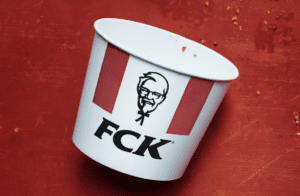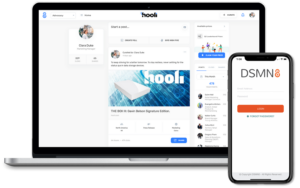
KFC witfully apologizes for running out of chicken back in 2017. (© KFC)
People don’t trust brands. Well, they trust some brands, but in 2020, consumers are more skeptical than ever about marketing, advertising, and just about any form of brand messaging.
The age of social media has made it near-impossible for consumers to escape the clutches of brands. With re-marketing and tracking, people feel as though brands are following them around online. It’s hard to argue with the logic of the 26% of people who now use ad blockers while browsing, the result of which could cost advertisers a total of more than $40 billion in 2020. Social media has allowed brands to be seen in more places than ever before. It’s easy to forget there’s a human behind the 280 characters.
What are brands doing about it?
Well, a few things. Most notably, brands are attempting to market their products through third parties. Whether through the use of social influencers or product placement, it seems there will always be a way to cut through.
The use of social influencers has skyrocketed over the last decade, and the growth shows no signs of slowing down. This BBC report describes how influencer salaries continue to soar year on year. The average asking price for an Instagram post has almost doubled in just one year (2018-2019).

Graph from the BBC shows how the asking price for an Instagram post has increased over time (© BBC, image source)
Much to the delight of social influencers (what with their asking prices), a report from Influencer Marketing Hub found that of the brands surveyed, 63% intended to increase their influencer spend in 2020. What many marketers fail to realize, however, is that the use of social influencers is much more transparent than it was in its hay day. Guidelines and law changes mean that brands and influencers alike are required by law to publicly state when a product/service is a result of a paid endorsement.
In 2018, the ASA, in collaboration with CAP, set out new guidelines for influencer marketing that made it even more difficult for influencers to promote branded content in an authentic way. It is now illegal for influencers to post sponsored content without disclosing it within the post, with brands and influencers alike being hit with hefty fines. After all, it’s not always plain sailing when brands are coughing up thousands to get influencers promoting their content. Check out this example of reality TV star Scott Disick for how not to do influencer marketing.

Social Influencer Scott Disick accidentally pastes a little too much post copy.
Even when they are used to great success, there’s no denying that the endorsement is transparent, and lacks the organic, human touch that consumers seem to be craving.
However, what seems to be increasingly effective, when correctly executed, is when brands address their followers as real people—talking as real people do, as opposed to spewing corporate jargon that almost always misses the mark and doesn’t resonate.
It seems just about every major brand is jumping on the comedic tweeting, meme-fueled bandwagon. From KFC responding to The Conservative Party’s attack on Jeremy Corbyn (to a phenomenal response) to Michael Gove citing lyrics by popular UK rapper Stormzy, it seemed 2019 was the year that every brand and politician had given a 20-something-year-old their Twitter credentials and told them to run away with it. Arguably to immeasurable success. The same chain of fried chicken made headlines after they plucked up the courage and humbly apologized for “running out of chicken” in an incredibly witty fashion.

KFC hilariously hits back at The Conservative party’s official Twitter (image source)
Cast your eye to popular American snack, the Slim Jim, who capitalized on social media and made themselves something of a meme. The brand organically grew its Instagram from 5k to 500k in just one year by having superfan, Andy Hines, run the account, instantly birthing a legion of meme-adoring fans, the self-proclaimed “Long Boi Gang.”
Brand Director Spencer Fivelson said that in 2018 before Hines officially joined the team, the Slim Jim Instagram content could be described as “underdeveloped and corporate.“
“Our Instagram content was attempting to be funny and gain attention, but it missed the mark… Consumers felt like they were being marketed to, and it was contrived.” – Spencer Fivelson (Brand Director)
Upon noticing that Andy Hines’ Slim Jim parody account had triple the followers of the Slim Jim corporate page, the brand invited him to a pop-up and subsequently hired Hines, offering him the title of “Chief Doing Things Officer.” Yes, seriously.

A typical meme-style post from the official Slim Jim Instagram (© Slimjim on Instagram)
Fivelson stated that, among other things, what the brand learned from working with Hines is that people don’t want a brand bombarding them with messaging and attempting to sell them products on Instagram. They want the Slim Jim page to “cure their boredom.”, which, in turn, raises brand awareness just as (if not more) effectively.
To the marketers that insist on an instant, measurable ROI over brand awareness, it’s worth considering that the humanization and less-corporate approach Slim Jim took to their advertising has seen to the brand growing at its fastest rate in over five years.
“We crossed the $600 million mark from a retail sales perspective, according to IRI data, and we are gaining market share.”
What about B2B brands?
While these examples have seen phenomenal kickback from their tongue in cheek efforts, it’s certainly not for every organization. Eyebrows were raised when politicians became involved in the comedic nature of Twitter, and we imagine the same would happen if out of nowhere, Citibank insisted on branding their premium Citigold members as “Big Spendy Bois.”
Of course, taking this approach to your social media and brand messaging can be a risky one. Though it works particularly well for public figures and B2C organizations, B2B brands need something a little more structured and secure.
Employee advocacy platforms seem to be the definitive solution for B2B and B2C brands alike to promote their brand message more authentically and with a more human touch. In short, employee advocacy is the promotion of an organization or its products/services by its employees. Advocacy allows brands to push their content to a broader audience, without it appearing to come directly from them. This is very much the reason why we’ve seen the meteoric rise of social influencers. After all, 93% of people say they are more likely to trust/engage with content from someone they know over any form of branded content.
The problem with most employee advocacy platforms is that they don’t offer enough text caption customization. Forcing participating employees to sound as though a marketer is talking for them, and also results in duplicated content.

DSMN8’s all-in-one employee influencer platform
DSMN8’s advocacy tool allows admin users to switch on a feature that enables all users to write their own text on a post. If admins still wish to control the tone of voice somewhat, they can include multiple imagery and post copy, which enables the syndication of content at scale in a unique way, removing in-feed duplication.
Not only does this mean that you have the opportunity to make each post totally unique and authentic, but it empowers your employees, too. Giving them some responsibility and the opportunity to represent the brand reinforces the idea that they are just as much a part of your company as the decision-makers are.
Are you ready to add a more human touch to your brand communications?
Ready to get started with the #1 employee advocacy platform?
Wondering how active your team already is, and how this compares with your competitors?
More on how brands are using social media:
Lewis Gray
Senior Marketing Manager and Employee Advocacy Program Manager at DSMN8. Lewis specialises in content strategy, growing brand visibility and generating inbound leads. His background in Sales lends itself well to demand generation in the B2B niche.


